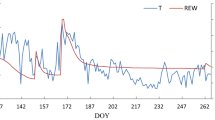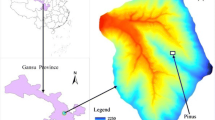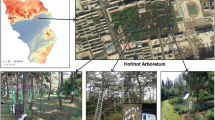Abstract
Populus simonii Carr trees are the most abundant species in Xinjiang farmland shelterbelt. They played an important role in protecting farmland ecosystem. Their stand transpiration rates and canopy conductances ranged from 0.14 to 1.02 cm d−1 and from 1.19*10−3 to 8.99*10−5 m s−1, respectively, during the 2014 growing season. Transpiration rate was showed quadratic polynomial regression with vapor pressure deficit (VPD) and air temperature (T), and exponential relationship with solar radiation (Rn). Furthermore, transpiration peaked at VPD, T, and Rn were 2.1 kPa, 23 °C, and 200 W m−2, respectively. Canopy conductance increased exponentially with the increasing Rn, whereas decreased logarithmically with the increasing VPD. Besides, transpiration increased with the increasing T and VPD ,and decreased sharply with the increasing soil water deficit. Finally, canopy conductance increased with the decreasing atmospheric water deficit. These results are not only providing the basis for more detailed analyses of water physiology and growth of Populus simonii Carr trees for the later application of a climate-driven process model, but also might have implications for farmland shelterbelt management.













Similar content being viewed by others
References
Allen CD et al (2010) A global overview of drought and heat-induced tree mortality reveals emerging climate change risks for forests. Forest Ecol Manag 259:660–684. doi:10.1016/j.foreco.2009.09.001
Anderegg WRL, Berry JA, Field CB (2012) Linking definitions, mechanisms, and modeling of drought-induced tree death. Trends Plant Sci 17:693–700
Anderegg WRL, Kane JM, Anderegg LDL (2013) Consequences of widespread tree Mortality triggered by drought and temperature stress nature. Clim Change 3:30–36
Bernier P, Bréda N, Granier A, Raulier F, Mathieu F (2002) Validation of a canopy gas exchange model and derivation of a soil water modifier for transpiration for sugar maple (Acer saccharum Marsh.) using sap flow density measurements. For Ecol Manage 163:185–196
Bonan GB (2008) Forests and climate change: forcings, feedbacks, and the climate benefits of forests. Science 320:1444–1449. doi:10.1126/science.1155121
Breda N, Huc R, Granier A, Dreyer E (2006) Temperate forest trees and stands under severe drought: a review of ecophysiological responses, adaptation processes and long-term consequences. Ann Forest Sci 63:625–644. doi:10.1051/forest:2006042
Campbell GS, Norman JM (1998) An introduction to environmental biophysics, 2nd edn. An introduction to environmental biophysics, Second edition
Chang X, Zhao W, Zhang Z, Su Y (2006) Sap flow and tree conductance of shelter-belt in arid region of China. Agric Forest Meteorol 138:132–141
Chen L, Wei W, Fu B, Lü Y (2007) Soil and water conservation on the Loess Plateau in China: review and perspective. Prog Phys Geogr 31:389–403
Chen LX, Zhang ZQ, Ewers BE (2012) Urban tree species show the same hydraulic response to vapor pressure deficit across varying tree size and environmental conditions. PLoS One 7:e47882. doi:10.1371/journal.pone.0047882
Chen LX, Zhang ZQ, Zha TG, Mo KL, Zhang Y, Fang XR (2014) Soil water affects transpiration response to rainfall and vapor pressure deficit in poplar plantation. New Forest 45:235–250. doi:10.1007/s11056-014-9405-0
Cheng X, Huang M, Shao M (2007) Vertical distribution of representative plantation’s fine root in wind-water erosion crisscross region, Shenmu
Chirino E, Bellot J, Sánchez JR (2011) Daily sap flow rate as an indicator of drought avoidance mechanisms in five mediterranean perennial species in semi-arid southeastern Spain. Trees 25:593–606
Dong X, Zhang Y, Cui W, Xun B, Yu B, Ulgiati S, Zhang X (2011) Emergy-based adjustment of the agricultural structure in a low-carbon economy in manas county of China. Energies 4:1428–1442. doi:10.3390/en4091428
Dzikiti S, Verreynne J, Stuckens J, Strever A, Verstraeten W, Swennen R, Coppin P (2010) Determining the water status of Satsuma mandarin trees [Citrus Unshiu Marcovitch] using spectral indices and by combining hyperspectral and physiological data. Agric For Meteorol 150:369–379
Fan ZZD, Zhu J, Jiang F, Yu X (2002) Advance in Characteristics of Ecological Effects of Farmland Shelterbelts. Journal of Soil and Water Conservation 16(4):130–133
Fernández ME, Gyenge J, Schlichter T (2009) Water flux and canopy conductance of natural versus planted forests in Patagonia. South America Trees 23:415–427
Ghimire CP, Lubczynski MW, Bruijnzeel LA, Chayarro-Rincon D (2014) Transpiration and canopy conductance of two contrasting forest types in the Lesser Himalaya of Central Nepal. Agric For Meteorol 197:76–90. doi:10.1016/j.agrformet.2014.05.012
Granier A (1987) Evaluation of transpiration in a Douglas-fir stand by means of sap flow measurements. Tree Physiol 3:309–320
Granier A, Bréda N, Biron P, Villette S (1999) A lumped water balance model to evaluate duration and intensity of drought constraints in forest stands. Ecol Model 116:269–283
Holder CD (2012) The relationship between leaf hydrophobicity, water droplet retention, and leaf angle of common species in a semi-arid region of the western United States. Agric For Meteorol 152:11–16
Hu M, Kang SZ, Zhang JH, Li FS, Du TS, Tong L (2012) Potential use of saline water for irrigating shelterbelt plants in the arid region. Irrigation Drain 61:107–115. doi:10.1002/ird.619
Huntington TG (2006) Evidence for intensification of the global water cycle: review and synthesis. J Hydrol 319:83–95. doi:10.1016/j.jhydrol.2005.07.003
Jarvis PG, McNaughton KG (1986) Stomatal control of transpiration—scaling up from leaf to region. Adv Ecol Res 15:1–49. doi:10.1016/s0065-2504(08)60119-1
Jonard F, Andre F, Ponette Q, Vincke C, Jonard M (2011) Sap flux density and stomatal conductance of European beech and common oak trees in pure and mixed stands during the summer drought of 2003. J Hydrol 409:371–381. doi:10.1016/j.jhydrol.2011.08.032
Jung EY, Otieno D, Kwon H, Berger S, Hauer M, Tenhunen J (2014) Influence of elevation on canopy transpiration of temperate deciduous forests in a complex mountainous terrain of South Korea. Plant Soil 378:153–172. doi:10.1007/s11104-013-2019-z
Kumagai T et al (2005) Effects of tree-to-tree and radial variations on sap flow estimates of transpiration in Japanese cedar. Agric For Meteorol 135:110–116. doi:10.1016/j.agrformet.2005.11.007
Kume T, Takizawa H, Yoshifuji N, Tanaka K, Tantasirin C, Tanaka N, Suzuki M (2007) Impact of soil drought on sap flow and water status of evergreen trees in a tropical monsoon forest in northern Thailand. For Ecol Manage 238:220–230
Lagergren F, Lindroth A (2002) Transpiration response to soil moisture in pine and spruce trees in Sweden. Agric For Meteorol 112:67–85. doi:10.1016/s0168-1923(02)00060-6
Li Wei SJ, Feng Qi, Tengfei YU (2013) Response of transpiration to water vapour pressure defferential of Populus euphratica. Journal of Desert Research 33:1377–1384
Li Xianyue YP, Ren Shumei, Ren Liang (2010) Characteristics and simulation of canopy conductnce of cherry Acta Ecologica Sinica:300-308
Li Zheng NL-h, Yuan Feng-hui,Guan Dexin.Wang Anzhi,Jin Changjie,Wu Jiabing (2012) Canopyconductancecharacteristicsof poplarinagroforestrysysteminwest LiaoningProvinceof Northeast China ChineseJournal of Applied Ecology:2975-2982
Licata JA, Gyenge JE, Fernandez ME, Schlichter TA, Bond BJ (2008) Increased water use by ponderosa pine plantations in northwestern Patagonia Argentina compared with native forest vegetation. For Ecol Manag 255:753–764. doi:10.1016/j.foreco.2007.09.061
Lu P, Urban L, Zhao P (2004) Granier’s thermal dissipation probe (TDP) method for measuring sap flow in trees: theory and practice. ACTA BOTANICA SINICA-ENGLISH EDITION 46:631–646
Luis V, Jiménez M, Morales D, Kucera J, Wieser G (2005) Canopy transpiration of a Canary Islands pine forest. Agric For Meteorol 135:117–123
McJannet D, Fitch P, Disher M, Wallace J (2007) Measurements of transpiration in four tropical rainforest types of north Queensland. Australia Hydrological Processes 21:3549–3564
Monteith JL (1965) Evaporation and environment. Symp Soc Exp Biol 19(19):205–234
Naithani KJ, Ewers BE, Pendall E (2012) Sap flux-scaled transpiration and stomatal conductance response to soil and atmospheric drought in a semi-arid sagebrush ecosystem. J Hydrol 464:176–185. doi:10.1016/j.jhydrol.2012.07.008
Pfautsch S, Bleby TM, Rennenberg H, Adams MA (2010) Sap flow measurements reveal influence of temperature and stand structure on water use of Eucalyptus regnans forests Forest Ecology and Management 259:1190–1199
Samuelson LJ, Stokes TA, Coleman MD (2007) Influence of irrigation and fertilization on transpiration and hydraulic properties of Populus deltoides. Tree Physiol 27:765–774
She DLX, xia Y, shao MA, peng SZ, Yu S (2013) Transpiration and canopy conductance of Caragana korshinskii trees in response to soil moisture in sand land of China. Agrofor Syst 87:667–678. doi:10.1007/s10457-012-9587-4
Shen Yanli, Yang Shixiu, Xinjie D (1999) Analysis of the function of Protection Forest Drainage and Water Consumption J Irrigation Drain:38-40
Sommer R, Sá TD, Vielhauer K, Araújo ACD, Fölster H, Vlek PL (2002) Transpiration and canopy conductance of secondary vegetation in the eastern Amazon. Agric For Meteorol 112:103–121
Sun LGW, Wang Y, Xu L, Xiong W (2011) Simulations of Larix principis rupprechtii stand mean canopy stomatal conductance and its responses to environmental factors. Chin J Ecol:2122-2128
Tanaka K et al. (2003) Transpiration peak over a hill evergreen forest in northern Thailand in the late dry season: assessing the seasonal changes in evapotranspiration using a multilayer model Journal of Geophysical Research: Atmospheres (1984–2012) 108
Tao W (2000) Land use and sandy desertification in the north China. Chinese J Agrometeorol 20:103–107
Wang T, Zhu Z, Wu W (2002) Sandy desertification in the north of China Science in China Series D. Earth Sci 45:23–34
Wang R, Ma L, Xi R, Xu J (2006) Fluctuation of Acer truncatum sap flow in rapid growth season and relevant variables. Chin J Ecol 2:231–237
Wanvestraut RH, Jose S, Nair PKR, Brecke BJ (2004) Competition for water in a pecan (Carya illinoensis K. Koch)—cotton (Gossypium hirsutum L.) alley cropping system in the southern United States. Agrofor Syst 60:167–179. doi:10.1023/B:AGFO.0000013292.29487.7a
Whitley R, Zeppel M, Armstrong N, Macinnis-Ng C, Yunusa I, Eamus D (2008) A modified Jarvis-Stewart model for predicting stand-scale transpiration of an Australian native forest Plant and Soil 305:35–47. doi:10.1007/s11104-007-9399-x
Whitley R, Medlyn B, Zeppel M, Macinnis-Ng C, Eamus D (2009) Comparing the Penman-Monteith equation and a modified Jarvis-Stewart model with an artificial neural network to estimate stand-scale transpiration and canopy conductance. J Hydrol 373:256–266. doi:10.1016/j.jhydrol.2009.04.036
Xi B, Li G, Bloomberg M, Jia L (2014) The effects of subsurface irrigation at different soil water potential thresholds on the growth and transpiration of Populus tomentosa in the North China Plain. Australian Forestry 77:159–167
Xiubin H, Zhanbin L, Mingde H, Keli T, Fengli Z (2003) Down-scale analysis for water scarcity in response to soil–water conservation on Loess Plateau of China. Agric Ecosyst Environ 94:355–361
Yue G, Zhao H, Zhang T, Zhao X, Niu L, Drake S (2008) Evaluation of water use of Caragana microphylla with the stem heat-balance method in Horqin Sandy Land Inner Mongolia, China. Agric For Meteorol 148:1668–1678
Yunusa IAM, Walker RR, Loveys BR, Blackmore DH (2000) Determination of transpiration in irrigated grapevines: comparison of the heat-pulse technique with gravimetric and micrometeorological methods. Irrig Sci 20:1–8. doi:10.1007/pl00006714
Yuwei ZHU, Yonghong WANG, Qimin CHEN, Weijiang WU, Fenfei ZUO (2010) Soil-coerced effect of farmland shelterbelt of Xinjiang 150 regiment. Protection Forest Science and Technology (4):9-11
Zamora DS, Jose S, Nair PKR (2007) Morphological plasticity of cotton roots in response to interspecific competition with pecan in an alleycropping system in the southern United States. Agrofor Syst 69:107–116. doi:10.1007/s10457-006-9022-9
Zeppel MJB, Macinnis-Ng CMO, Yunusa IAM, Whitley RJ, Earnus D (2008) Long term trends of stand transpiration in a remnant forest during wet and dry years. J Hydrol 349:200–213. doi:10.1016/j.jhydrol.2007.11.001
Zhou H, Li X, Fan H, Wang X, Tan H, Li A (2004) Physiological characteristics of several Caragana shrub species under extreme conditions. J Desert Res 25:182–190
Zweifel R, Häsler R (2001) Dynamics of water storage in mature subalpine Picea abies: temporal and spatial patterns of change in stem radius. Tree Physiol 21:561–569
Acknowledgments
This study was financially supported by the National Natural Science Foundation of China (41371115).
Author information
Authors and Affiliations
Corresponding author
Rights and permissions
About this article
Cite this article
FU, S., Sun, L. & Luo, Y. Canopy conductance and stand transpiration of Populus simonii Carr in response to soil and atmospheric water deficits in farmland shelterbelt, Northwest China. Agroforest Syst 91, 1165–1180 (2017). https://doi.org/10.1007/s10457-016-0002-4
Received:
Accepted:
Published:
Issue Date:
DOI: https://doi.org/10.1007/s10457-016-0002-4




